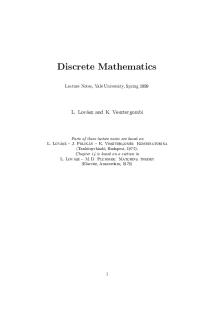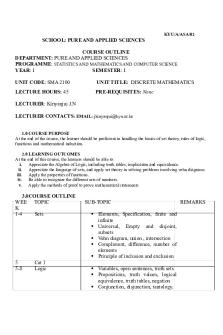Discrete Mathematics - Lecture 5.1 Mathematical Induction PDF

| Title | Discrete Mathematics - Lecture 5.1 Mathematical Induction |
|---|---|
| Course | Discrete Mathematics |
| Institution | University of Houston |
| Pages | 8 |
| File Size | 872.9 KB |
| File Type | |
| Total Downloads | 21 |
| Total Views | 136 |
Summary
Discrete Mathematics - Lecture 5.1 Mathematical Induction...
Description
Math 3336 Section 5.1 Mathematical Induction • • • •
Mathematical Induction Examples of Proof by Mathematical Induction Mistaken Proofs by Mathematical Induction Guidelines for Proofs by Mathematical Induction
Suppose we have an infinite ladder: 1. We can reach the first rung of the ladder. 2. If we can reach a particular rung of the ladder, then we can reach the next rung. Page 1 of 8
Principle of Mathematical Ind complete these steps: • ow that • : Show
is true for
we
true for all positive integers k.
To complete the inductive step, assuming the inductive hypothesis that P(k) holds for an arbitrary integer k, show that must P(k + 1) be true. Important points about Mathematical Induction • Mathematical induction can be expressed as the rule of inference where the domain is the set of positive integers. )) → ∀n P(n) •
• •
In a proof by mathematical induction, we don’t assume that P(k) is true for all positive integers! We show that if we assume that P(k) is true, then P(k + 1) must also be true. Proofs by mathematical In such a case, the basis step begins at l see examples of this soon. Mathematical Induction s not give insights on why a theorem works.
Example: Show that if
, then 1 + 2 + ⋯ + =
(+1) 2
.
Example: Conjecture a formula for the sum of the first n p the conjecture using mathematical induction.
Page 3 of 8
. Then prove
≥ 4.
Page 4 of 8
Example: Prove that 3 − is divisible by 3 whenever n is a
Page 5 of 8
.
Example: Use mathematical induction to prove that 7
Page 6 of 8
+1
is divisible by 57 for
Example: Use mathematical induction to show that if S is a finite set with n elements, where , then S has 2 subsets.
Page 7 of 8
Mistaken Proofs by Mathematical Induction Example (All horses are white): Let (): “All horses are the same color.” Basic Step: (1) is true. Inductive Step: Assume that () is true, so that all horses in a set of horses are the same color. Consider any + 1 horses; number these as horses 1,
+ 1.
Now the first of these horses all must have the same color, and the last of these must have the same color. Because the set of the first and the last k overlap, all + 1 must have the same color. This shows that ( + 1) is true and finishes the proof by induction.
Page 8 of 8...
Similar Free PDFs

Mathematical Induction
- 3 Pages

Discrete mathematics worksheet 2
- 1 Pages

Discrete Mathematics lesson 2
- 2 Pages

MAT 145 - Discrete Mathematics
- 139 Pages

Discrete Mathematics (CS6105)
- 108 Pages

BST Discrete Mathematics
- 3 Pages
Popular Institutions
- Tinajero National High School - Annex
- Politeknik Caltex Riau
- Yokohama City University
- SGT University
- University of Al-Qadisiyah
- Divine Word College of Vigan
- Techniek College Rotterdam
- Universidade de Santiago
- Universiti Teknologi MARA Cawangan Johor Kampus Pasir Gudang
- Poltekkes Kemenkes Yogyakarta
- Baguio City National High School
- Colegio san marcos
- preparatoria uno
- Centro de Bachillerato Tecnológico Industrial y de Servicios No. 107
- Dalian Maritime University
- Quang Trung Secondary School
- Colegio Tecnológico en Informática
- Corporación Regional de Educación Superior
- Grupo CEDVA
- Dar Al Uloom University
- Centro de Estudios Preuniversitarios de la Universidad Nacional de Ingeniería
- 上智大学
- Aakash International School, Nuna Majara
- San Felipe Neri Catholic School
- Kang Chiao International School - New Taipei City
- Misamis Occidental National High School
- Institución Educativa Escuela Normal Juan Ladrilleros
- Kolehiyo ng Pantukan
- Batanes State College
- Instituto Continental
- Sekolah Menengah Kejuruan Kesehatan Kaltara (Tarakan)
- Colegio de La Inmaculada Concepcion - Cebu









